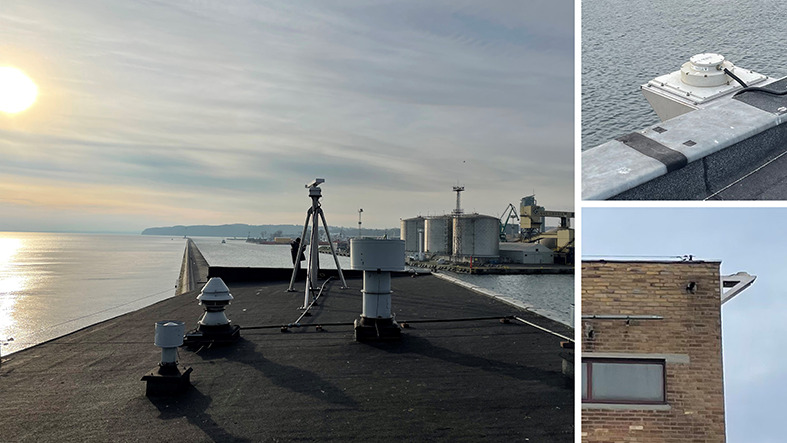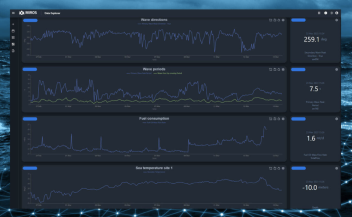Miros’ sensors provide valuable insights to validate the use of unmanned vehicles for port operations at the port of Gdynia
Miros has installed a tailored environmental monitoring system to support a three-year research project at the port of Gdynia in Poland.




Image: Miros’ environmental monitoring system installed on the roof of a harbour building at a strategic location in the port of Gdynia. Miros RangeFinder as part of WaveWeather dry-mounted at the upper roof side.
The bespoke system provides accurate current and wave measurements and oil spill monitoring from a strategic location in the bay of Gdansk. The expected results will be used to create recommendations for the operation of unmanned units in ports and will be made available to governmental organisations.
The gathered sea state data will be combined with a hydrodynamic model to calculate and forecast hydro-meteorological conditions in the Gdynia harbour area. A major project milestone was achieved in February 2022 when data first became available via Miros Cloud.
The research project is investigating the benefits of using mobile unmanned platforms to perform observations and surveillance work in ports. This is the result of an international consortium consisting of five entities: Port of Gdynia Authority S.A., Gdansk University of Technology, Gdynia Maritime University, Norwegian Institute of Water Research, and Miros AS.
The system is a combination of a Miros Wavex radar with oil spill detection capability and WaveWeather, the company’s high-performance, remote, dry sensors for the measurement of directional waves, meteorological parameters, water level and surface currents.
The research project’s findings will determine the degree of reliability of bathymetric surveys and automatic water sampling conducted by unmanned vehicles. Based on the data obtained during the project, 3D models will be created to predict the movement of specific substances such as oil spills. This will be supplemented by tests in the harbour, which will provide several practical insights and enable the faster improvement of previously implemented solutions.
Emilie Dorgeville, VP Business Development, Ports & Renewables at Miros commented: “This pan-European project is a testament to our expertise in advanced environmental monitoring. The measured data is made available in real-time through Miros Cloud for the navigational authorities and all partners involved in the project.
“The collected wave and current information will be combined with a three-dimensional hydrodynamic model run by the Norwegian Institute for Water Research to calculate and forecast hydro-meteorological conditions in the Gdynia harbour area. The data resulting from Miros’ sensors will be used to support with oil spill detection and recovery operations at the port. We are proud to support this innovative project looking at changing and simplifying the routines in port surveillance and operations.”
Jacek Sadaj, President of the Port of Gdynia Authority added: “The data provided by the sensors is invaluable for tracking surface currents and waves in the Port of Gdynia. This will be very useful during field operations, for example, supporting decision-making processes during the deployment of buoys, drifters and moorings, as well as in the event of oil spills.”
The research project
The project received funding through The Polish-Norwegian Research Programme as part of the POLNOR 2019 call program operated by Poland’s National Centre of Research and Development. This is one of the largest bilateral programmes of this type in Europe, aiming to grant €71 million to dozens of interdisciplinary research projects in various fields, including environmental protection, climate change, polar research, social sciences, and carbon capture and storage.
The tailored Miros environmental monitoring system
The system will collect meteorological and water level data. The combination of a 3D GEMSS hydrodynamic model (run by NIVA) and Miros’ instrumentation makes it possible to calculate and forecast hydro meteorological conditions in the Gdynia harbor area. Miros’ sensors will be important in collecting and transmitting sea state information.
Miros’ oil spill detection (OSD) system will mainly provide data contributing to the decision-making system in the Gdynia harbor. The wave and current descriptions for the area where a potential oil spill has been identified will be provided in support of an oil recovery operation. The OSD system will provide automatic alarms and situational awareness when an oil spill appears on the ocean surface. The data generated will support response decisions and planning. An important element of the project is also the use of an unmanned unit that, depending on the data obtained, will move to selected locations in the harbour to take water samples and make measurements.
About Port of Gdynia
The Port of Gdynia is a universal port and one of the leading ports in the southern Baltic Sea. It specializes in handling general cargo, mainly unitized, transported in containers and in the ro-ro system. An important segment of activity is also handling bulk cargo based on specialized terminals. The Port of Gdynia is a recognized brand in transport and logistics systems around the world. The port’s development strategy assumes its further development as a universal port, capable of receiving the largest container, mass and passenger ships calling at the Baltic Sea. A breakthrough step for the opening of the Port of Gdynia to ocean-going ships is the 2018 reconstruction of the turning basin No. 2.
Read more about our solutions for the Ports & Coastal segment.
Find more Ports & Coastal resources: Case Studies, Webinars, Datasheets and more


